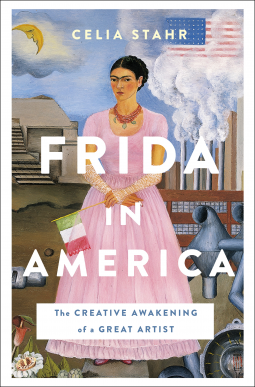 |
In 2015, I saw the Detroit Institute of Art (DAI) exhibition Diego Rivera and Frida Kahlo in Detroit. I knew Diego Rivera from the DIA court murals but I had known little about Frida Kahol. Reading Frida Kahol in America by Celia Stahr, specifically about Kahlo's time in Detroit, I could clearly remember her painting of her miscarriage in Henry Ford Hospital. We listened to the story on headphones and studied the unforgettable painting.
Although the exhibit included works by Rivera, it was Kahlo's that stuck in my mind. Rivera's painting of a flower seller was more accessible, 'prettier', but Kahlo's self-portraits grabbed my attention--those eyes, so direct and almost challenging, her self-confidence and self-acceptance revealed.
Stahr shares that many who knew both Rivera and Kahlo said Kahlo was the better artist. She stood in the shadow of her husband's charismatic personality, diminished by the press, struggling to develop her artistic voice.
Kahlo was in her early twenties when she married the older, famous artist, only twenty-three when they arrived in America. Her life had already been eventful, suffering polio, scoliosis, spina bifida, and the life-threatening bus accident when she was a teenager. Pain accompanied her every day. She was a Communist, she challenged society's prescribed sex roles, and had suffered heartbreak as a spurned lover.
It was so interesting to see American during the Depression through Kahlo's eyes. The wealthy industrialists were her husband's patrons--they paid the bills. They also represented a privileged class Kahlo who found revolting.
Kahlo wrote to her mother, "Witnessing the horrible poverty here and the millions of people who have no work, food, or home, who are cold and have no hope in this country of scumbag millionaires, who greedily grab everything, has profoundly shocked [us]."
Of course, I was very interested in the artists' time in Detroit. The city had been one of the hardest hit by the Depression, 50% unemployed. I was shocked to read about the Ford Hunger March. Ford had reduced salaries and laid off workers, and since the workers lived in Ford housing they became homeless as well. Four thousand marched in freezing weather to the gate of the Rouge River plant to be met by bullets and fire hoses, killing four people. River and Kahlo arrived a month after the event.
Stahr addresses the duality "at the root of Frida's sense of self," part of her "search for a unification of opposites, as the Aztecs and alchemists espoused."
Kahlo's deeply personal art defied convention, delving into female experiences never depicted in art before. In comparison, Rivera's masterpiece murals at the Detroit Institute of Art look to the past, glorifying the pre-Depression industrial worker and the scientists and entrepreneurs who created industry.
These same industrialist millionaires were aiding Hitler, Ford a known anti-semite, and oil companies supplying fuel and poisonous gasses to the Nazis.
"Love is the basis of all life," Stahr quotes Kahlo. Love of country, for friends and family, sexual love, for home. Her relationship with Rivera was conflicted, their love affairs rending their marriage, resulting in divorce and remarriage.
This is a revealing and deep study of Kahlo that truly educated me while engaging me emotionally with its subject.
I was given a free ebook from the publisher through NetGalley in exchange for a fair and unbiased review.
Frida Kahlo in America: The Creative Awakening of a Great Artist
by Celia Stahr
St. Martin's Press
On Sale: 03/03/2020
ISBN: 9781250113382
hardcover $29.99; $14.99 ebook
Learn more about the DIA exhibit at
https://www.mlive.com/news/detroit/2015/03/diego_rivera_and_frida_kahlo_i.html
 |
| Memorialized in Rivera's mural, Edsel Ford and William Valentiner chose Rivera to paint the walls of the DIA courtyard |
After Detroit, they went to New York City where Rivera was to create a mural for the new Rockefeller Center and a battle over a patron's control of an artist's content played itself out. It could have happened in Detroit, but the scandalous murals drew record crowds to the DIA and turned around their finances.
"Love is the basis of all life," Stahr quotes Kahlo. Love of country, for friends and family, sexual love, for home. Her relationship with Rivera was conflicted, their love affairs rending their marriage, resulting in divorce and remarriage.
This is a revealing and deep study of Kahlo that truly educated me while engaging me emotionally with its subject.
I was given a free ebook from the publisher through NetGalley in exchange for a fair and unbiased review.
Frida Kahlo in America: The Creative Awakening of a Great Artist
by Celia Stahr
St. Martin's Press
On Sale: 03/03/2020
ISBN: 9781250113382
hardcover $29.99; $14.99 ebook
 |
| Frida Kahlo, Self-Portrait on the Borderline between Mexico and the United States of America (1932) |
Learn more about the DIA exhibit at
https://www.mlive.com/news/detroit/2015/03/diego_rivera_and_frida_kahlo_i.html




